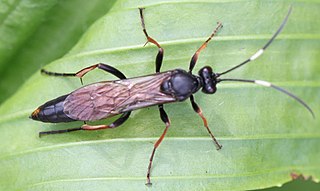
The Percidae are a family of ray-finned fish, part of the order Perciformes, which are found in fresh and brackish waters of the Northern Hemisphere. The majority are Nearctic, but there are also Palearctic species. The family contains more than 200 species in 11 genera. The perches and their relatives are in this family; well-known species include the walleye, sauger, ruffe, and three species of perch. However, small fish known as darters are also a part of this family.

Aethria is a genus of tiger moths in the family Erebidae. There are about 13 described species in Aethria, found in the Neotropics.

Acaenitinae is a subfamily of the parasitoid wasp family Ichneumonidae. Female Acaenitinae have a large triangular projecting genital plate.
Latibulus is a genus of wasps in the family Ichneumonidae. There are two species in Europe:
Owenus is a genus of ichneumonid wasp, named for Denis Owen.

Anomalon is a large genus of parasitoid wasps belonging to the family Ichneumonidae. This may be the only genus in the tribe Anomalonini, although Neogreeneia Viereck, 1912 is sometimes considered a valid genus of the tribe.
Coccygodes is a genus of wasps in the subfamily Cryptinae, tribe Cryptini and subtribe Baryceratina.

Lusius is a genus of parasitoid wasps in the tribe Phaeogenini Förster, 1869 or Alomyini Förster, 1869, first described by Pierre Jules Tosquinet in 1903, published after his death. The genus is similar in appearance to species in the genus Heterischnus. Lusius occurs in the Oriental, Afrotropical, Neotropical and Australasian biogeographical regions.

Echthrus is a genus of ichneumon wasps in the family Ichneumonidae.

Apsilops is a genus of ichneumon wasps in the family Ichneumonidae. There are about nine described species of Apsilops.

Stenichneumon is a genus of ichneumon wasps in the family Ichneumonidae. There are at least 20 described species in Stenichneumon.

Theronia is a genus of ichneumon wasps in the family Ichneumonidae. There are at least 30 described species in the genus Theronia. The genus has a worldwide distribution and includes species that are endoparasitoids or hyperparasitoids of Lepidoptera.

Aptesis is a genus of parasitoid wasps belonging to the family Ichneumonidae. The genus was first described by Arnold Förster in 1850 and has almost cosmopolitan distribution.

Charops is a genus of parasitoid wasps belonging to the family Ichneumonidae.

Diplazon is a genus of parasitoid wasps belonging to the family Ichneumonidae.
Eriborus is a genus of parasitoid wasps belonging to the family Ichneumonidae.

Barylypa is a genus of parasitoid wasps belonging to the family Ichneumonidae.
Notosemus is a genus of parasitoid wasps belonging to the family Ichneumonidae. There are about eight described species in Notosemus, found in Europe.













